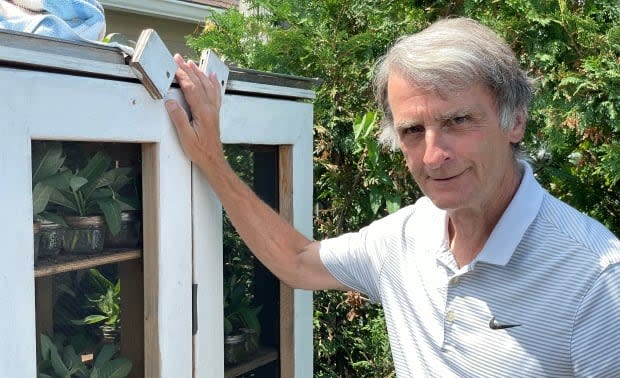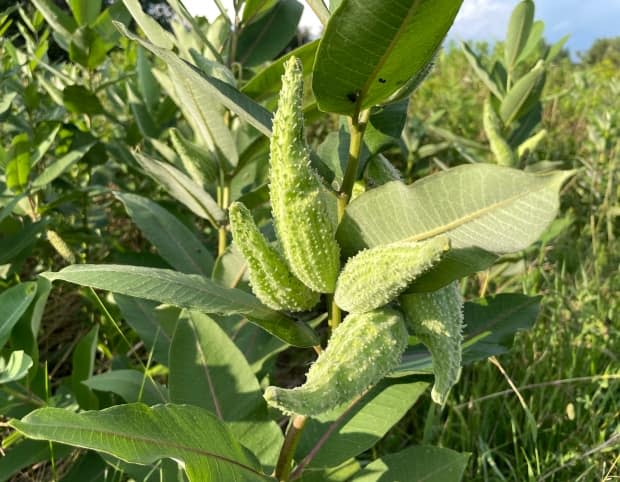Montreal conservationists work to save vanishing Monarch butterflies from extinction

At his home on Montreal's south shore, Roger Giraldeau makes his way to his nursery.
Opening the door, he delicately lifts up a mason jar filled with water. Protruding from a hole in the metal cover are a bunch of milkweed leaves.
"These are my babies," he said, pointing to the black, yellow and white-stripped caterpillars clinging to the leaves.
Those caterpillars are about halfway through their metamorphosis. From egg, to caterpillar, to chrysalis, they will then reach their final form: Monarch butterflies.
But the 100 or so caterpillars in Giraldeau's nursery wouldn't be here if it weren't for him.
He searches and saves eggs before the plant they're on gets mowed down for landscaping along highways or in shopping mall lands.
"People always ask me, what is the use of a butterfly? And I always turn it back to them and ask, what is mankind useful for? We destroy everything," he said.
"I try to help those who have no chance of surviving."
Surviving for Monarch butterflies is getting harder and harder.
Scientists believe the population of the butterflies has diminished by as much as 80 per cent since the 1980s.

Tracking the diminishing Monarch population
At the Montreal Botanical Garden, Alessandro Dieni kneels down over an imported species of milkweed called Asclepias curassavica, or tropical milkweed.
"[The Monarchs] come all the way from Mexico, simply to feed and to complete their life cycle — and they can only do that with the presence of milkweed," said the co-ordinator of the Botanical Garden's Monarch Mission campaign.
"It's the only plant that the caterpillars can feed on."
It's also where the butterflies lay their eggs.
This week, amateurs and experts alike across North and South America, are taking part in the International Monarch Monitoring Blitz.
Participants simply input their observations online after spotting milkweed plants, eggs, or any form of the butterflies.
"The aim of that blitz is to gather a better picture, a better snapshot of what's going on in Canada," Dieni said.
What's going on, isn't good news. Pinpointing the reasons behind the decline isn't simple, but in Canada, partly to blame is loss of habitat: The precious milkweed plant.

Montreal's field of Monarchs
You don't have to go very far to find a Monarch habitat in danger of disappearing.
In Montreal's west end, next to the Trudeau International airport, lies a huge swath of land many refer to as the Technoparc Montréal, although the 200 hectares of woods and fields there have no official name.

"We have everything here. We have wetlands, we have mixed wood forest, we have swampy forest and we have this open space that is excellent for a variety of species that would hunt and feed here, including the Monarch butterfly," says Katherine Collin, an amateur birder and member of the TechnoParc Oiseaux, a group fighting for the land to be protected.
Past the forest, and in the fields, are thousands upon thousands of milkweed plants, a haven for the Monarchs who come in the summer.
A large portion of the land is owned by the federal government, but leased to the administration in charge of the airport, the Aéroports de Montréal (ADM).
It's land they hope to develop.
"There are indeed negotiations underway with a company that would like to set up in the northern sector of the airport site," ADM spokesperson Anne-Sophie Hamel confirmed to Radio-Canada.
For members of TechnoParc Oiseaux, they can't understand why there isn't a will to protect the butterflies.
"I won't advance the case that habitat loss in Montreal is as serious as habitat loss in their migratory destination in Mexico," said Collin.
"But it's still a grave threat because the urban habitat loss that we see, if we're doing away with milkweed, then the Monarchs don't have anywhere to come to reproduce and begin their trajectory back. So, yes, it's a serious threat."


 Yahoo Finance
Yahoo Finance 